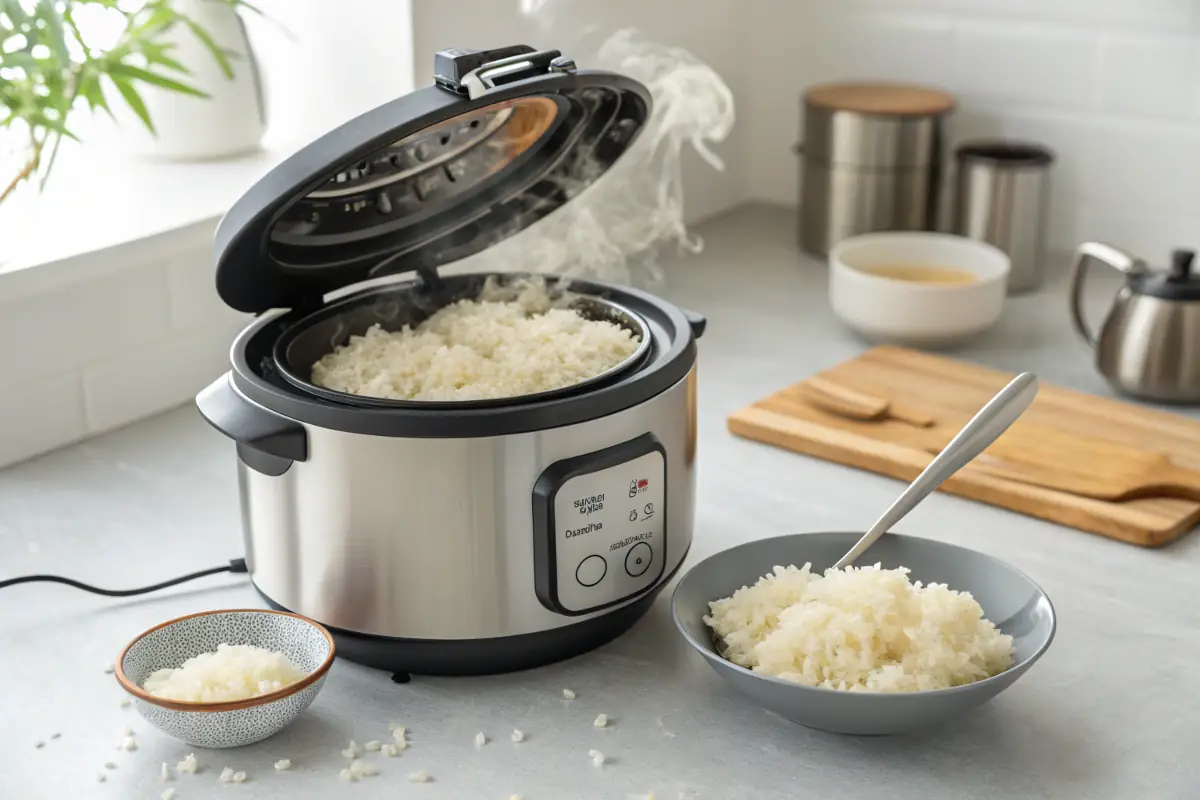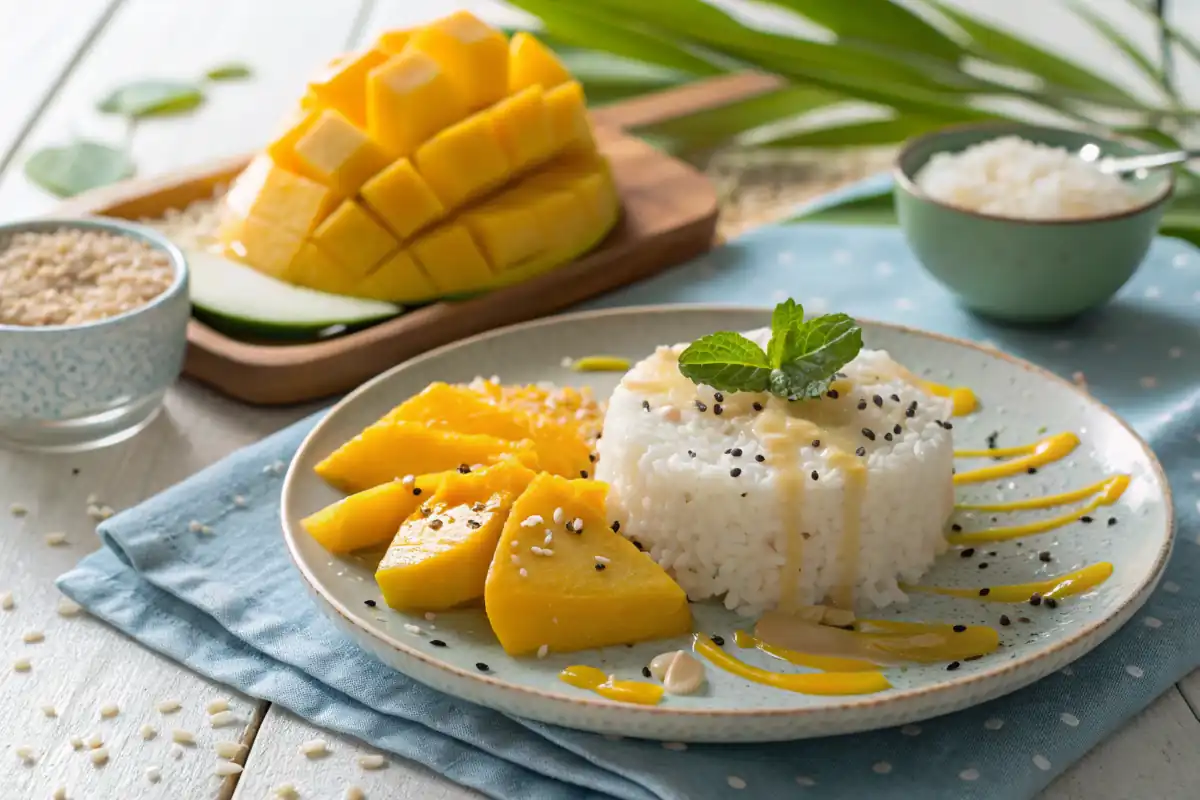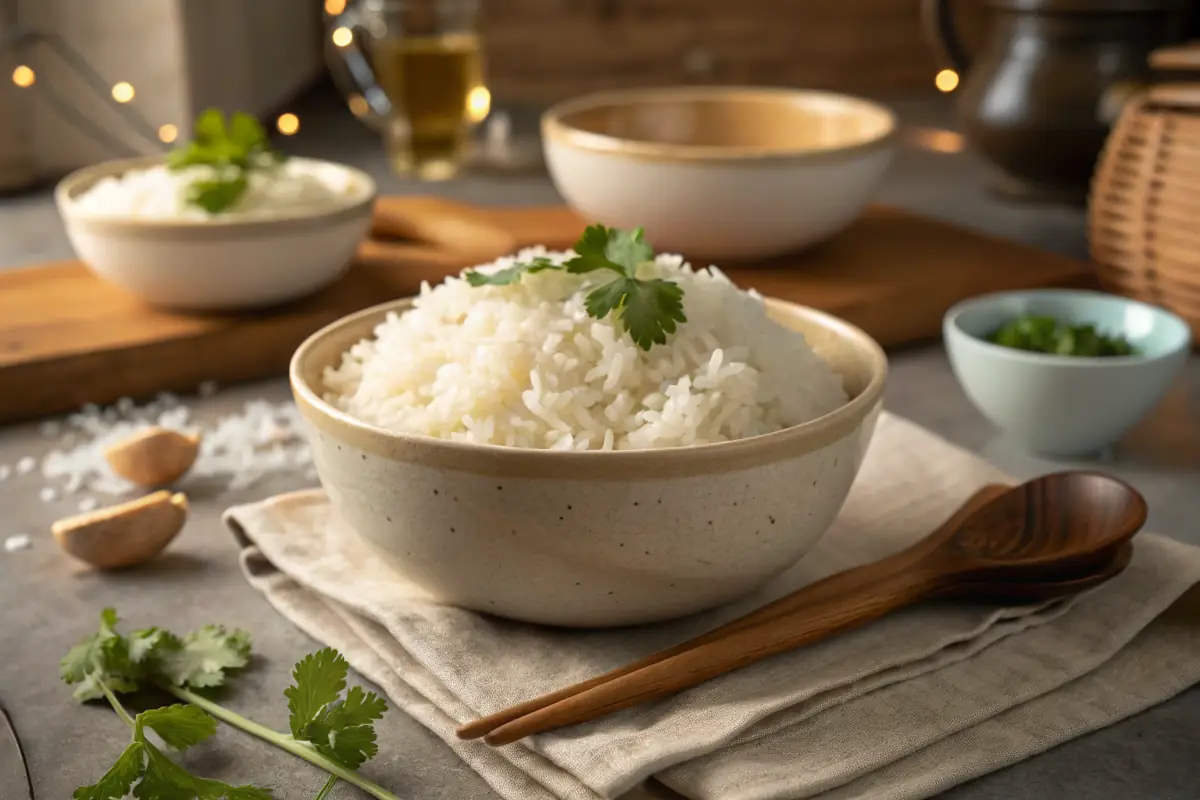Cooking jasmine rice in an Instant Pot should be a straightforward process, right? Yet, many of us have opened that lid expecting perfectly fluffy rice, only to find a sticky, gummy mess instead. Why is my jasmine rice so sticky in the Instant Pot? If you’ve found yourself wondering this, don’t worry—you’re not alone. Sticky rice is a common issue, but it’s also one that can be solved with a few simple tweaks and tips.
In this article, we’ll dive deep into why this happens, common mistakes that might be sabotaging your efforts, and how to fix them. Plus, we’ll share a foolproof guide for cooking perfectly fluffy jasmine rice every time. Whether you’re a seasoned cook or new to Instant Pot magic, this guide will turn your rice game around. Let’s get started!
Understanding the Problem
What Does Sticky Jasmine Rice Mean?
Sticky jasmine rice doesn’t necessarily mean it’s inedible, but it’s far from ideal if you’re aiming for that fluffy, separated texture. Jasmine rice, by nature, contains a good amount of starch, which can clump the grains together during cooking. While some dishes (like sushi) call for stickier rice, most people prefer jasmine rice to be light and fluffy.
Stickiness often happens when the starch on the surface of the rice grains isn’t properly rinsed off before cooking. This excess starch thickens in the water, coating the grains and making them cling together like glue.
Why Stickiness Happens in Jasmine Rice: Natural Factors
Unlike basmati or long-grain white rice, jasmine rice has shorter, slightly plumper grains and naturally contains more amylopectin, a type of starch responsible for its soft texture. This starch profile makes jasmine rice aromatic and tender but also makes it prone to clumping when overcooked or not prepared correctly.
Additionally, jasmine rice absorbs water more quickly than other varieties, which means even a slight miscalculation in the water-to-rice ratio can leave you with overly sticky results.
The Instant Pot’s Role in the Texture of Jasmine Rice
The Instant Pot is a fantastic tool for cooking rice, but its high-pressure, steam-heavy environment can amplify the factors that lead to sticky rice. Here’s why:
- The sealed design traps steam, creating a moist environment that’s perfect for tender rice but also encourages clumping.
- Unlike stovetop cooking, where you can adjust heat and release steam, the Instant Pot operates on a fixed cycle. This makes it easy to overcook jasmine rice if you’re not careful with timing or settings.
- Warm mode can worsen stickiness, as the residual heat causes the rice to continue steaming and breaking down.
Understanding these factors is the first step toward mastering jasmine rice in the Instant Pot. Now that we’ve broken down the why, let’s explore common mistakes and how to fix them in the next section.
Common Mistakes When Cooking Jasmine Rice in an Instant Pot
Not Rinsing the Rice Properly
One of the biggest culprits behind sticky jasmine rice is skipping the rinsing step. Jasmine rice is coated in a thin layer of starch, and when this starch isn’t removed, it creates a gluey, sticky texture during cooking. Rinsing your rice under cold water until the water runs clear helps wash away excess starch, making your rice less likely to clump together. Skipping this simple step is a recipe for sticky disaster, especially when using an Instant Pot.
Incorrect Water-to-Rice Ratio
Ah, the water ratio—the make-or-break factor in cooking perfect jasmine rice! Using too much water floods the rice, overhydrating the grains and creating a mushy, sticky texture. On the flip side, using too little water can leave the rice undercooked. For jasmine rice in the Instant Pot, the golden rule is often a 1:1 ratio of water to rice. However, feel free to experiment slightly depending on your desired consistency.
For more insights into perfect rice measurements, check out this helpful guide on jasmine rice ratios.
Using the Wrong Cooking Settings on the Instant Pot
The Instant Pot comes with multiple settings, but not all are ideal for jasmine rice. Using the “Manual” or “Pressure Cook” setting at high pressure for 4-6 minutes is usually the sweet spot. Many users accidentally use the “Rice” button, which can result in overcooking since it’s optimized for a different type of rice. Also, letting the rice sit in “Keep Warm” mode for too long can trap excess moisture and make the rice sticky.
Leaving the Rice in Warm Mode for Too Long
After the cooking cycle ends, leaving jasmine rice in warm mode might seem harmless, but it can lead to excess stickiness. The trapped heat and moisture continue to soften the rice, creating a texture that’s more gluey than fluffy. Instead, release the pressure naturally for about 10 minutes, then remove the rice immediately to fluff it with a fork.
How to Fix Sticky Jasmine Rice
Rinsing and Washing Techniques to Remove Excess Starch
If your cooked rice turns out sticky, all hope isn’t lost! You can fix it by rinsing the cooked rice under warm water. Use a colander to gently rinse the rice, shaking it slightly to separate the grains. This helps remove the surface starch that makes the rice cling together. Be careful not to agitate the rice too much, as this could break the grains.
Adjusting the Water Ratio for the Perfect Consistency
To avoid sticky rice in the future, take note of your water ratio. For jasmine rice in the Instant Pot, a 1:1 ratio is often ideal. But if you prefer slightly drier rice, reduce the water slightly (e.g., 1 cup of rice to 7/8 cup of water). It’s better to err on the side of less water; you can always add a splash if the rice seems undercooked after the pressure release.
Tweaking Instant Pot Settings for Fluffy Rice
Your Instant Pot settings can make or break your jasmine rice. Stick to the “Pressure Cook” setting on high for 4 minutes, followed by a 10-minute natural release. After that, manually release the remaining pressure, fluff the rice immediately, and serve. These steps ensure your rice comes out tender without being sticky.
What to Do If the Rice Still Turns Out Sticky
Sometimes, despite your best efforts, the rice still turns out sticky. When this happens, spread the rice on a large plate or tray to cool it down quickly. As it cools, the grains will naturally separate. Another trick? Add a splash of olive oil or butter while fluffing to coat the grains and reduce stickiness.
By following these methods, you can confidently tackle the question: Why is my jasmine rice so sticky in the Instant Pot? Stay tuned for the next part, where we’ll share a foolproof step-by-step guide for perfect jasmine rice!
Step-by-Step Guide to Cooking Perfect Jasmine Rice in an Instant Pot
Essential Ingredients and Equipment Needed
Cooking jasmine rice in an Instant Pot doesn’t require much, but the right tools and ingredients can make all the difference. Here’s what you’ll need:
- 1 cup of jasmine rice (adjust quantities as needed)
- 1 cup of water (for a perfect 1:1 ratio)
- A fine-mesh strainer for rinsing the rice
- A wooden spoon or rice paddle for fluffing
Optional ingredients, like a pinch of salt or a teaspoon of butter, can add flavor but aren’t necessary for fluffy rice. Before you start, make sure your Instant Pot’s inner pot is clean and dry.
Preparation: Rinsing and Measuring

Start by rinsing your jasmine rice under cold water in a fine-mesh strainer. Use your fingers to gently agitate the rice, removing as much surface starch as possible. This step is crucial for avoiding sticky rice. Continue rinsing until the water runs clear—don’t rush it!
Next, measure your water and rice precisely. The 1:1 ratio is your go-to guide for fluffy jasmine rice. If you’re making a larger batch, simply scale up the measurements evenly.
Cooking Method: Settings and Timing
Add the rinsed jasmine rice and water directly into the Instant Pot. Close the lid, ensure the valve is set to “Sealing,” and select the “Pressure Cook” setting. Set the timer to 4 minutes at high pressure.
Once the cooking cycle ends, let the pressure release naturally for about 10 minutes. This allows the rice to finish steaming and prevents overcooking. Afterward, switch the valve to “Venting” to release any remaining pressure. Open the lid carefully.
For more detailed tips on cooking rice to perfection, check out our Instant Pot jasmine rice guide.
Post-Cooking Tips for Best Results
Immediately fluff the rice with a wooden spoon or rice paddle. Avoid stirring too vigorously, as this can break the grains. If you’re not serving the rice right away, transfer it to a separate dish to cool slightly. This prevents it from continuing to steam in the Instant Pot, which can lead to unwanted stickiness.
Preventive Tips for Avoiding Sticky Jasmine Rice in the Future
The Importance of Proper Storage for Jasmine Rice
Properly storing jasmine rice ensures its long-term quality. Always keep your rice in a cool, dry place, preferably in an airtight container to prevent moisture or pests from spoiling it. Fresh jasmine rice tends to cook more evenly and results in better texture compared to older rice.
Using High-Quality Jasmine Rice for Better Results
All jasmine rice isn’t created equal. Opt for high-quality, authentic Thai jasmine rice, as it has the right balance of starch and aroma. Cheaper varieties or blends often have inconsistent results, making it harder to achieve fluffy, non-sticky rice.
Developing a Habit of Testing Water Ratios
Even though the 1:1 ratio is reliable for most cooks, small adjustments might be needed depending on your Instant Pot model or personal preferences. Start with the recommended ratio, and if the rice comes out too sticky, slightly reduce the water next time. Remember, practice makes perfect!
By following these tips, you’ll never have to ask yourself Why is my jasmine rice so sticky in the Instant Pot? again. In the next section, we’ll tackle some common FAQs to ensure you’re fully prepared to cook jasmine rice like a pro!
FAQs About Cooking Jasmine Rice in an Instant Pot
Why Does My Rice Always Come Out Sticky, Even When I Rinse It?
If your jasmine rice is still sticky even after rinsing, it could be due to the water ratio or cooking time. Using too much water or leaving the rice on “Keep Warm” mode for too long can lead to excess moisture, making the rice clump together. Additionally, rinsing helps but won’t solve the problem entirely if you skip proper measurements or settings. Stick to the 1:1 ratio and try natural pressure release for consistent results.
Can I Fix Already Cooked Sticky Jasmine Rice?
Yes, you can rescue sticky jasmine rice! Start by spreading it out on a large plate or tray to cool. You can also rinse the rice under warm water using a colander and gently separate the grains with your fingers or a fork. While it may not be as fluffy as perfectly cooked rice, it will be much more usable for dishes like fried rice or rice salads.
Does the Type of Water Affect the Stickiness of the Rice?
Believe it or not, the type of water you use can impact your jasmine rice. Hard water, which contains more minerals, can sometimes make the rice stickier. If you’ve tried adjusting your cooking technique without success, consider using filtered water to see if it improves your results.
What Is the Ideal Cooking Time for Jasmine Rice in the Instant Pot?
The perfect cooking time for jasmine rice in the Instant Pot is around 4 minutes at high pressure, followed by a 10-minute natural pressure release. This method allows the rice to cook evenly without becoming too soft or mushy. Avoid releasing the pressure immediately, as this can disrupt the steaming process.
Wrapping Up – The Journey to Perfect Jasmine Rice
Perfecting jasmine rice in the Instant Pot doesn’t have to be a mystery. By understanding the common causes of stickiness—like skipping the rinse, misjudging the water ratio, or using incorrect settings—you can turn your rice woes into wins. The key lies in a few simple adjustments and knowing the ins and outs of your Instant Pot.
From troubleshooting sticky rice to mastering the perfect texture, this guide answers the ever-persistent question: Why is my jasmine rice so sticky in the Instant Pot? With these tips and techniques, you’ll achieve consistently fluffy, aromatic rice that’s a delight to eat and a breeze to cook.
Remember, practice and experimentation are part of the journey. If your first attempt isn’t perfect, don’t sweat it. Make small changes, such as adjusting the water ratio or experimenting with different brands of rice. Each time, you’ll get closer to your ideal bowl of jasmine rice.
For more kitchen tips, tricks, and recipes, be sure to explore the rest of our site. Whether you’re learning how to cook grains or diving into bold new dishes, we’ve got you covered. Now, it’s time to grab your Instant Pot and make the best jasmine rice you’ve ever tasted!
Creative Ways to Use Sticky Jasmine Rice
Transforming Sticky Rice into Delicious Dishes
If you find yourself with sticky jasmine rice, don’t let it go to waste! Sticky rice can be repurposed into a variety of dishes where its texture becomes an advantage rather than a problem. For instance, you can turn it into fried rice. The slightly clumpy grains work wonderfully in stir-fries because they hold together and soak up sauces without falling apart. Just add a splash of oil, some veggies, and your favorite protein for a quick and satisfying meal.
Sticky jasmine rice also makes a fantastic base for rice pudding. Combine it with milk, sugar, and a pinch of cinnamon, then simmer until creamy. This comforting dessert is a great way to give sticky rice a sweet twist.
Adding Sticky Rice to Global-Inspired Recipes

Sticky jasmine rice pairs beautifully with cuisines that naturally embrace its texture. Try making sushi rolls, where the stickiness helps the rice bind to the nori. Alternatively, use it to create Thai sticky rice with mango—a traditional dessert that combines sweet coconut rice with ripe, juicy mango slices.
By reframing your perspective, you can turn the question Why is my jasmine rice so sticky in the Instant Pot? into a creative opportunity to explore new flavors and recipes. Sticky rice might not be what you originally intended, but it’s still incredibly versatile and delicious.
Final Thoughts and Encouragement
Embracing the Learning Process
Cooking jasmine rice in the Instant Pot is a skill that takes time to perfect. If you’ve ever asked yourself, Why is my jasmine rice so sticky in the Instant Pot?, know that you’re not alone. This is a common issue that even seasoned cooks face. The key is to understand what causes the problem and make small adjustments to your technique.
Remember, every mistake in the kitchen is an opportunity to learn. Whether you need to rinse more thoroughly, tweak your water ratio, or experiment with cooking settings, each effort gets you closer to consistently fluffy, aromatic jasmine rice.
A Journey to Consistent Success
Mastering jasmine rice in the Instant Pot is about finding the right balance of preparation, timing, and patience. With the tips and strategies outlined in this guide, you’re well-equipped to turn sticky rice into a thing of the past. Or, when it happens, you can confidently use it in creative dishes like rice pudding, sushi, or mango sticky rice.

